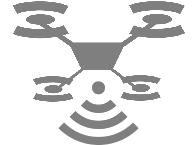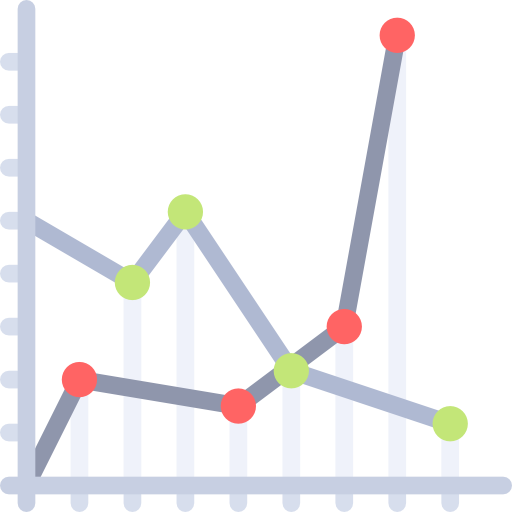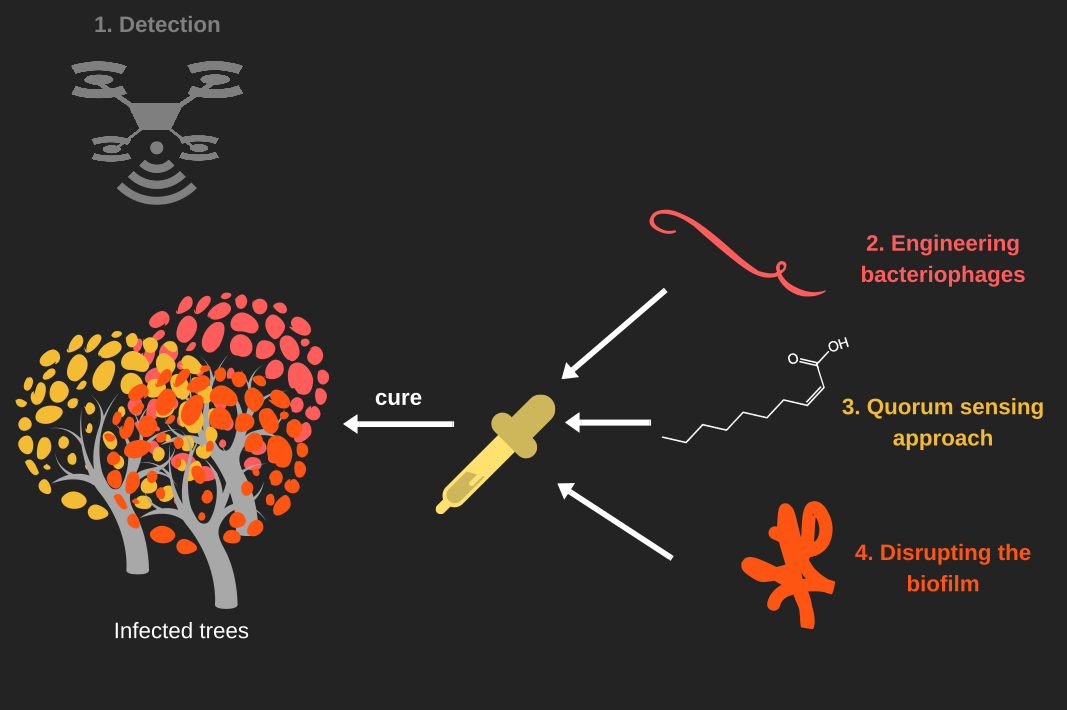|
|
| (44 intermediate revisions by 6 users not shown) |
| Line 1: |
Line 1: |
| | {{Aix-Marseille|title=KILL XYL|toc=__TOC__}} | | {{Aix-Marseille|title=KILL XYL|toc=__TOC__}} |
| − | ==Abstract==
| |
| | | | |
| − | '''KILL XYL''' is a cure against the disease caused by ''Xylella fastidiosa'', a plant pathogene. Currently, no extensive cure exists against this disease that causes the loss of thousands of hectares of European crops.
| + | [[File:T--Aix-Marseille--KX.png|500px|right|thumb|KILL XYL project.]] |
| − | '''KILL XYL''' has the goal to detect the symptom of the disease, then use specific phage-like particles in order to inject toxins into ''X. fastidiosa''. Finally, with the help of fatty acid it quenches the quorum sensing activity of the bacterium and with an enzyme it degrades the biofilm, which is the principal cause of plants death.
| + | |
| − | To be specific to ''X. fastidiosa'', '''KILL XYL''' uses a specific phage-like particle able to recognize the pili and some extracellular proteins by which the bacterium can be identified in a background of millions.
| + | |
| | | | |
| − | ==Motivation==
| + | Our project '''KILL XYL''' is to find a cure for the disease caused by the plant pathogen [[Team:Aix-Marseille/Xylella_fastidiosa|''Xylella fastidiosa'']]. This disease currently causes the loss of thousands of acres of European crops and currently there is no cure for it. |
| | + | |
| | + | At Aix-Marseille University, we thought about developing a solution that focuses on multiple aspects. First, we wanted to improve [[Team:Aix-Marseille/Hardware|detection]] of the disease. To do this we used an NDVI camera that would help us to see if the plant is stressed or not. If the plant is infected by [[Team:Aix-Marseille/Xylella_fastidiosa|''Xylella fastidiosa'']], it suffers from a hydric stress that stops the photosynthesis. |
| | | | |
| − | [[File:T--Aix-Marseille--Xylellaworldwide.png|500px|left|thumb|Distribution map of ''Xylella fastidiosa'' worldwide.]] | + | Secondly, we wanted to get rid of the bacteria. |
| | + | Phages are natural predators of bacteria. |
| | + | They can also be used to transfer DNA into bacteria. |
| | + | Phages have the additional advantages of being strain specific and in some cases customizable. |
| | + | As we wanted an eco-friendly treatment |
| | + | to facilitate obtaining [[Team:Aix-Marseille/Legislation|marketing authorizations]], |
| | + | we decided to create [[Team:Aix-Marseille/Bacteriophages|phage-like particles]] (PLPs), that aren't able to spread. |
| | + | So we set out the construction of a phage specific to [[Team:Aix-Marseille/Xylella_fastidiosa|''X. fastidiosa'']], |
| | + | capable of injecting genes coding for toxic proteins into the bacteria. |
| | | | |
| − | ''Xylella fastidiosa'' is a bacterium that infects the xylem tissues of a wide range of plants. This bacterium has been widespread in the Americas for many years and occurs also in Asia. The bacterium is associated with several diseases of crops of economic significance, and has a wide range of host plants comprising 312 species. | + | The main cause of the plant mortality in the case of an infection by [[Team:Aix-Marseille/Xylella_fastidiosa|''X. fastidiosa'']] is hydric stress induced by the accumulation of biofilm in xylem vessels. |
| | + | To disrupt the biofilm we thought about two different approaches. |
| | + | The first is to keep the bacteria from producing extra-cellular polysaccharides. |
| | + | We achieve this by [[Team:Aix-Marseille/QS|quenching bacterial quorum sensing]] using a short chain fatty acid called: 2-cis-decenoic acid. |
| | + | The second approach is to destroy the biofilm's exo-polysaccharides using an [[Team:Aix-Marseille/DEPS|enzyme]] obtained from a bacteriophage to hydrolyse the polysaccharides. |
| | | | |
| − | ''X. fastidiosa'' is transmitted from plant to plant by xylem sucking insects. The bacterium can persist in symptomless uncultivated plants, from which insects may acquire the bacterium and pass it to crops. Symptoms of disease are only observed when xylem vessels are highly colonized by the bacterium. The xylem transports water and soluble mineral, nutrients from the roots throughout the plant, and used to replace water lost during transpiration and photosynthesis. Xylem vessels are interconnected by bordered pits, which allow the passage of xylem sap, but block the passage of larger objects (such as bacterium) by a membrane. | + | Hence, '''KILL XYL''' simply detects the disease, disrupts biofilm and kills [[Team:Aix-Marseille/Xylella_fastidiosa|''Xylella fastidiosa'']]. |
| | | | |
| − | The control of the movement of potential hosts and insect vectors and the eradication of infected material is considered the most effective method of limiting the spread of the disease in the European Union. But there is no method yet to cure the trees.
| + | <div class="row-icons"> |
| − | | + | * [[File:T--Aix-Marseille--drone.png|link=Team:Aix-Marseille/Hardware]]<span class="legend">Detection</span> |
| − | ==KILL XYL concept==
| + | * [[File:T--Aix-Marseille--icon-phage.png|link=Team:Aix-Marseille/Bacteriophages]]<span class="legend">Engineering PLPs</span> |
| − | | + | * [[File:T--Aix-Marseille--icon-QS.png|link=Team:Aix-Marseille/QS]]<span class="legend">Quorum sensing</span> |
| − | [[File:T--Aix-Marseille--KX.png|500px|left|thumb|KILL XYL project.]] | + | * [[File:T--Aix-Marseille--icon-deps.png|link=Team:Aix-Marseille/DEPS]]<span class="legend">Disrupting biofilm</span> |
| − | | + | * [[File:T--Aix-Marseille--icon-model.png|link=Team:Aix-Marseille/Model]]<span class="legend">Modelling</span> |
| − | At Aix-Marseille University we thought about a solution that enclose many aspect of the cure.
| + | </div> |
| − | | + | |
| − | First, we wanted to improve the detection of the disease, to do so we wanted to use a NDVI camera that will help us to see if the plant do photosynthesis or not. If the plant is heavily affected by ''Xylella fastidiosa'', it support a hydric stress that stop the photosynthesis.
| + | |
| − | | + | |
| − | Secondly, we want to get rid of the bacterium. Phages are natural predators of bacteria. They can also be used to transfect DNA into a bacterial cell. Phages has also the advantage of being specific to a strain and to be modulable. As we wanted to be eco-friendly, we create phage-likes particles, that aren't able to spread. Thus we have nanobots specific to ''Xylella fastidiosa'', capable to inject toxic genes into the bacterium.
| + | |
| − | | + | |
| − | The main cause of the plants death, is the hydric stress induced by the accumulation of biofilm into the xylem vessels. To disrupt the biofilm we thought about different solutions. The first one is to stop the bacterium producing any extra poly-saccharide. This could be achieved by quenching the quorum sensing of the bacterium with the help of a little fatty acid called : 2-cis-decenoic acid. Secondly, we wanted to destroy the exo-polysaccharids. An enzyme coming from a bacteriophage could fulfill the use by the hydrolysis of polysaccharides.
| + | |
| − | | + | |
| − | Hence, '''KILL XYLL''' simply detects, disrupt and kill ''Xylella fastidiosa''.
| + | |
| − | | + | |
| − | ===Module 1: Detection of the disease=== | + | |
| − | | + | |
| − | ===Module 2 : Engineering bacteriophages===
| + | |
| − | | + | |
| − | [[File:T--Aix-Marseille--Phage.png|400px|left|thumb|Phage-like particles process.]] | + | |
| − | | + | |
| − | Bacteriophages play a special role in nanoscale cargo-delivery developments, because they can be regarded as naturally occurring nanomaterials. Viral nanoparticles (VNPs), in particular bacteriophages, are attractive options for cargo-delivery as they are biocompatible, biodegradable, and non-infectious to mammals.
| + | |
| − | | + | |
| − | Phage systems, like M13, have been employed in biotechnological applications, most prominently in the identification and maturation of medically-relevant binding molecules through phage display. The application of phages in materials and nanotechnology is mainly due to their nanoscale size and simple life cycles. We choose to use those application in our advantage in order to target ''Xylella fastidiosa'' and other pathogenic bacteria.
| + | |
| − | | + | |
| − | [[Team:Aix-Marseille/Bacteriophages|Read more…]]
| + | |
| − | | + | |
| − | ===Module 3 : Quorum sensing approach=== | + | |
| − | | + | |
| − | ''Xylella fastidiosa'' uses quorum sensing, as an inter-bacterial communication system, to regulate its biofilm production. The quorum sensing is based on the emission of specific fatty acid, there are fatty acids antagonistic to its quorum sensing, this disturbance is called quorum quenching. 2-cis-decenoic acid is one of these fatty acids whom has quorum quenching effect to ''Xylella fastidiosa''. This action of quenching will prevent the formation of biofilm, dependent of the quorum sensing and therefore will have both action preventive and curative to the symptoms caused by the biofilm on the plants. We want to produce this fatty acids from ''E. coli'' to inoculated the infected trees. Thus saving the plants from ''Xylella fastidiosa''.
| + | |
| − | | + | |
| − | [[Team:Aix-Marseille/QS|Read more…]]
| + | |
| − | | + | |
| − | ===Module 4 : Disrupting the biofilm=== | + | |
| − | | + | |
| − | Extracellular polysaccharide (EPS) is a major virulence factor of Xylella Fastidiosa, the causative agent of Olive Quick Decline (OQD) associated with binding of water, ions and nutrients; keeping them in close contact with the bacteria; and protection against the recognition by plant cell defense mechanisms.
| + | |
| − | Some bacteriophages carry coat proteins that can degrade bacterial polysaccharides. The Depolymerase binds to the capsular EPS and degrades the polymer until the phage reaches the cell surface, where it binds to an outer membrane receptor and injects nucleic acid to initiate the lytic cycle.
| + | |
| − | To disrupt the biofilm we centered our research on this enzyme, which we called deps to cleave the extracellular polysaccharides of Xylella Fastidiosa freeing up the tension cause by EPS in the xylem vessels. I hope that curing the plant from the hydric stress caused by the bacteria.
| + | |
| − | | + | |
| − | | + | |
| − | [[Team:Aix-Marseille/DEPS|Read more…]] | + | |
| − | | + | |
| − | ==InterLab== | + | |
| − | | + | |
| − | We used plasmids containing different promoter from the 2017 distribution kit and transfect into ''E.coli''. Before measuring fluorescence expression, we used LUDOX and fluorescein to calibrate the TECAN. We prepared a dilution series of fluorescein in 4 replicates and measure the fluorescence in a 96 well plate in a plate reader. By measuring these in all standard modes, we generated a standard curve of fluorescence for fluorescein concentration. We used this to correct cell based readings to an equivalent fluorescein concentration and convert this into a concentration of GFP.
| + | |
| − | | + | |
| − | [[Team:Aix-Marseille/InterLab|Read more…]]
| + | |
| − | | + | |
| − | ==Modelisation==
| + | |
KILL XYL
Our project KILL XYL is to find a cure for the disease caused by the plant pathogen Xylella fastidiosa. This disease currently causes the loss of thousands of acres of European crops and currently there is no cure for it.
At Aix-Marseille University, we thought about developing a solution that focuses on multiple aspects. First, we wanted to improve detection of the disease. To do this we used an NDVI camera that would help us to see if the plant is stressed or not. If the plant is infected by Xylella fastidiosa, it suffers from a hydric stress that stops the photosynthesis.
Secondly, we wanted to get rid of the bacteria.
Phages are natural predators of bacteria.
They can also be used to transfer DNA into bacteria.
Phages have the additional advantages of being strain specific and in some cases customizable.
As we wanted an eco-friendly treatment
to facilitate obtaining marketing authorizations,
we decided to create phage-like particles (PLPs), that aren't able to spread.
So we set out the construction of a phage specific to X. fastidiosa,
capable of injecting genes coding for toxic proteins into the bacteria.
The main cause of the plant mortality in the case of an infection by X. fastidiosa is hydric stress induced by the accumulation of biofilm in xylem vessels.
To disrupt the biofilm we thought about two different approaches.
The first is to keep the bacteria from producing extra-cellular polysaccharides.
We achieve this by quenching bacterial quorum sensing using a short chain fatty acid called: 2-cis-decenoic acid.
The second approach is to destroy the biofilm's exo-polysaccharides using an enzyme obtained from a bacteriophage to hydrolyse the polysaccharides.
Hence, KILL XYL simply detects the disease, disrupts biofilm and kills Xylella fastidiosa.
-
 Detection
Detection
-
 Engineering PLPs
Engineering PLPs
-
 Quorum sensing
Quorum sensing
-
 Disrupting biofilm
Disrupting biofilm
-
 Modelling
Modelling



